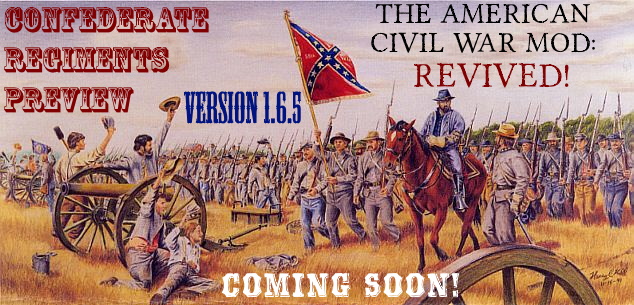
Patriotism and love of country demand a ready response from all men capable of bearing arms!
As we approach the release of the new update for the mod, we are now ready to reveal six of the new Confederate regiments that we have been working on. As with our previous article, we will show some pictures of the regiments in game, as well as discuss their history, how they are dressed and equipped, how they perform in the mod, and where they will be found in the troop tree. A huge thank you to Matsuri5 for his amazing work on many of these uniforms, his tireless and passionate dedication to this project helps make all of this possible. Our combined efforts have produced a very impressive result and we are quite satisfied with what we have accomplished. We hope you enjoy this preview of half of the new Confederate regiments, and we are eagerly looking forward to the release of the new update after this.
11th Mississippi Infantry Regiment "University Greys"
The University Greys (or Grays) were Company A of the 11th Mississippi Infantry Regiment, part of the Army of Northern Virginia. The Greys served in many of the most famous and bloody battles of the war. The rifle company joined the 11th Infantry at its inception on May 4th, 1861 after Mississippi seceded from the Union. Their name "University Greys" derived from the gray color of the men's uniforms and from the fact that almost all of the Greys were students at the University of Mississippi. 135 men enlisted with the regiment, which was nearly the entire student body; only four students reported for classes in the autumn of 1861, so few that the university closed temporarily.
On July 18th, 1861, the 11th Mississippi were ordered to support General Beauregard at Manassas. The sick were left at Winchester and the regiment marched through Ashby’s Gap to Piedmont. Companies A and F under Lieutenant Colonel Liddell boarded a train for Manassas with the 2nd Mississippi. Companies A and F arrived at Manassas at about noon on July 20th. They accompanied the 2nd Mississippi and were put in a supporting position behind McLean’s and Blackburn’s Fords on Bull Run. The rest of the regiment under Colonel Moore boarded the train that had been sent back from Manassas. It would not reach the battlefield in time for the battle. On July 21st, companies A and F under Lieutenant Colonel Liddell were sent along with General Bernard Bee’s brigade to reinforce the endangered left flank. They arrived at the scene of the fighting around 11:00 a.m., crossing Young’s Branch and forming a defensive line that was supported by two batteries. Under heavy small arms and artillery fire that mortally wounded General Bee, the companies fell back with heavy losses and reformed behind Jackson’s Brigade. They then joined Jackson in the attack on the Union batteries. The two companies lost 7 men killed and 21 wounded in this engagement.
The regiment was present at the Battle of Seven Pines from May 31st to June 1st, 1862, where they supported the 3rd Alabama in its attack on the 52nd New York. They then moved to the front line, taking heavy casualties, including Captain William B. Lowry, who was wounded in the face. In mid-June, the regiment was sent with Whiting’s Division to temporarily reinforce Jackson’s Army of the Valley. On June 27th, the 11th Mississippi, with the rest of Law’s Brigade and Hood’s Brigade, charged and broke the center of the Union line at the Battle of Gaines' Mill. Of the 400 men engaged, 18 were killed, 142 wounded, and 3 missing. Major Evans, Captain Reuben O. Reynolds, and Captain George Shannon were wounded in the fighting.
The 11th Mississippi was present for the Battle of Malvern Hill on July 1st, but did not take an active part in the fighting. However, 1 man was killed and 20 were wounded from artillery fire. In mid-July, the regiment with Whiting’s Division was transferred to Longstreet’s Command. General Whiting left on medical leave on the 26th, and Brigadier General John B. Hood took over command of the division. The regiment was engaged at the Battle of Second Manassas from August 29th to the 30th, losing 4 men killed and 55 wounded. The 11th marched from Hagerstown to Turner’s Gap along the National Road, arriving at around 3 p.m. to participate in the Battle of South Mountain. The regiment launched a bayonet charge to turn back Union troops who were forcing their way through the pass. On the 15th, the regiment withdrew to a position behind Antietam Creek near Sharpsburg. Hood’s Division acted as the rearguard for the army. The next day, they were positioned by the Dunker Church, and threw back a Union advance at dusk along the Smoketown Road. Colonel Liddell was mortally wounded, and later died from this wound on September 25th. Lt. Colonel Samuel F. Butler took command of the regiment. September 17th marked the first day of the Battle of Antietam, and being attacked at dawn by Union General Joseph Hooker’s First Corps, Hood’s Division counterattacked in the infamous corn field. General Hood wrote of this engagement:
“I soon became engaged with an immense force of the enemy, consisting of not less than two corps of their army. It was here that I witnessed the most terrible clash of arms, by far, that has occurred during the war. The two little giant brigades of this division wrestled with this mighty force, losing hundreds of their gallant officers and men, but driving the enemy from his position and forcing him to abandon his guns on our left.”
The 11th Mississippi lost 8 men killed and 96 wounded out of around 200 men. Lt. Colonel Butler was mortally wounded in the stomach, later dying from this wound on October 3rd, and Major Taliaferro Evans was killed when he took command from Butler. During this engagement, the 11th Mississippi's color bearer was killed and the regimental colors lost.
In the Spring of 1863, the regiment and its brigade joined General Longstreet for the Suffolk Campaign. The 11th, along with Longstreet’s command, returned to Lee’s army on the Rappahannock in May, but arrived too late to take part in the Battle of Chancellorsville. On July 1st, the regiment was assigned to guard the baggage trains and missed the opening fighting of the Battle of Gettysburg. It rejoined Davis' Brigade on July 2nd, but the brigade was held in reserve due to its heavy casualties the day before. On the 3rd day of battle, the brigade took part in Pickett’s Charge. The 11th Mississippi was the regiment on the left flank of the brigade. Brockenbrough’s Brigade took heavy fire from its front and flank by artillery fire and collapsed well short of the Union lines. They were also subjected to a surprise musket volley from the 8th Ohio Infantry regiment, which so surprised Brockenbrough's Virginians—already demoralized by their losses to artillery fire—that they panicked and fled back to Seminary Ridge, crashing through Trimble's division and causing many of his men to flee as well. The 11th Mississippi's colors and a handful of men made it to the stone wall that was the Union defensive line and were killed or captured there. The Greys penetrated further into the Union lines than any other Confederate regiment, but at a terrible cost. Major Reynolds was wounded, and Company A, the University Greys, were completely wiped out, with every man from the company being killed or wounded in Pickett's Charge. In total, of the 393 men from the 11th Mississippi that were engaged, 110 were killed in action or died of wounds, 193 were wounded or captured while wounded, and 37 were taken as prisoners of war, uninjured. Those who survived Gettysburg were merged with the 11th Mississippi's Company G, the “Lamar Rifles”, where they served out the remainder of the Civil War.
On July 14th, the regiment served with the rest of Heth’s Division as rear guard for Lee’s Army while crossing the Potomac at the Battle of Falling Waters. The 11th was temporarily under the command of General Pettigrew since Heth's wound at Gettysburg on July 1st. Here the regiment fought off an attack by Union cavalry, losing 9 men. In October, the 11th Mississippi was engaged at Bristoe Station, losing 4 men wounded. From November to December 1863, the regiment participated in the Mine Run Campaign, and then wintered in camp near Orange Court House.
On May 5th, 1864, the 11th Mississippi moved up the Orange Plank Road to meet Union forces moving through the wilderness. The regiment was on the left of Heth’s Division, north of the Plank Road, and held off a series of attacks by Union General Hancock’s Second Corps. The brigade was relieved at dusk by Thomas’ Brigade of Wilcox’s Division and moved south of the Plank Road. On May 6th, the Union pre-dawn attack broke the Confederate line but the 2nd, 11th, 29th and 42nd Mississippi regiments held the line for two hours until Longstreet’s reinforcements reached the battlefield and launched a counterattack. The brigade reformed and attacked when Longstreet was wounded and his attack stalled. It pushed back Union troops threatening an Alabama brigade, then built and defended a log barricade until withdrawn to Lee’s defensive line. On May 10th, Colonel Francis Green was mortally wounded at the Battle of Po River, later dying on the 15th, and Major Reuben O. Reynolds took command of the regiment. From May 12th to the 21st, the regiment was only lightly engaged as skirmishers at the Battle of Spotsylvania Courthouse. Casualties for the regiment for the first two weeks of May were 14 killed, 55 wounded and 6 missing.
From May 23rd to the 26th, the 11th Mississippi was engaged at the Battle of North Anna, and on June 3rd, the regiment participated in the Battle of Cold Harbor, losing 6 men killed, 31 wounded and 4 missing. The regiment was present for the Siege of Petersburg, and on August 18th, the regiment took part in a counterattack at the Battle of Weldon Railroad, which broke two Union brigades, then dug in and held the ground it had gained. 10 men were killed and 30 wounded in this battle. On September 30th, the regiment fought along Squirrel Level Road at the Battle of Peeble's Farm. On October 3rd, in a raging downpour, General Heth launched a number of uncoordinated attacks against what he mistakenly thought was a hanging Union flank. The attacks were beaten back by the well entrenched Federals, costing the 11th Mississippi 1 killed, 3 wounded and 1 missing. The regiment then went on to participate in the Battle of Boyden Plank road on the 27th.
On March 25th, 1865, Colonel Reynolds was wounded at the Skirmish at Hawk's Farm, losing his right arm, and Captain Nelms was badly wounded as well. Lieutenant Colonel George Shannon took command of the regiment, which had started the battle with only 64 men. On April 2nd, the regiment was flanked on both sides during the breakthrough and collapse at Petersburg, and retreated to Hatcher’s Run. The stream was unfordable due to heavy rains, so Lieutenant Colonel Shannon and most of the regiment were forced to surrender, although some of the men escaped by swimming the dangerously swollen waters. Color bearer Frank Hope tore the regiment's colors to pieces and threw the staff into the water.
In the mod:
The 11th Mississippi Infantry Regiment is represented by Company A, "The University Greys". They wear grey uniforms with red facings and their black hats come with a red cord, an infantry cap badge on the front, and the brim folded on the side, with a star shaped badge above it. They carry M1841 Mississippi Rifles and fight with their bayonets fixed. The Greys are a fierce infantry regiment, and their accurate rifles make them effective on a firing line at distances where other infantry regiments would struggle to hit their mark. The men are skilled shooters and strong in melee, making them one of the more elite units available to the Confederacy. The University Greys can be found under the Army of the Tennessee as an upgrade from the Confederate Regulars Sharpshooters.
31st Alabama Infantry
The 31st Alabama Infantry Regiment was organized at Talladega, on the 16th of March, 1862, with men from Calhoun, Cherokee, Montgomery, Randolph, Shelby, and Talladega counties. It reported to General Danville Leadbetter at Chattanooga shortly after. It then moved up to Knoxville, where it was brigaded under General Seth Barton, in Carter Stevenson's Division. Men often enlisted in a company recruited in the counties where they lived though not always. After many battles, companies might be combined because so many men were killed or wounded. The regiment took part in the fight at Cumberland Gap and Tazewell but was not engaged when it moved into Kentucky.
The regiment was ordered to Mississippi and permanently brigaded with the 20th, 23rd, 30th, and 46th Alabama, under the command of General Edward D. Tracy. The 31st went on to fight at the battles of Chickasaw Bayou, Port Gibson, Champion's Hill, and Vicksburg. In December, the 31st Alabama accompanied Stevenson's Division to Vicksburg. In May 1863 the regiment was initiated into the sternest duties of war, helping to defend Port Gibson, Mississippi, where the regiment suffered severely. The regiment went on to fight at Baker's Creek, and the losses they sustained there were very heavy. As part of the garrison of Vicksburg, the regiment shared in the dangers and privations of that siege, and, after losing a number killed and wounded, was surrendered with the fortress. Losses to the 31st at Vicksburg were 21 killed in action, and 37 wounded. Placed in parole camp at Demopolis, the 31st was soon exchanged and reorganized under the brigade of General Edmund Pettus, going on to participate in many of the battles of the Army of Tennessee. The regiment was engaged with slight loss at Mission Ridge, wintered at Dalton, and participated in the campaign from Dalton to Atlanta, having a full share in the dangers and hardships which have made the 31st a bloody but proud page in history.
The regiment followed General John Bell Hood into Tennessee and sustained severe losses at Columbia and Nashville, and served as the rear guard of the retreating army. Transferred to North Carolina, the regiment was hotly engaged at Bentonville, and a fragment of the 1,100 with which it entered the service surrendered at Greensboro, as part of Pettus' Brigade. Only 180 men were fit for duty in January 1865, and less than 100 surrendered in April. Toward the close of the war, the 31st was consolidated with the 23rd and 46th Infantry and re-designated the 23rd Consolidated Infantry Regiment at Smithfield, on the 9th of April, 1865.
In the mod:
The 31st Alabama Infantry Regiment wears a brownish-grey uniform with light blue trousers, and a grey kepi with blue trim. They carry Pattern 1853 Enfield Rifle Muskets, and Springfield Model 1855, 1861, and 1863 Rifle Muskets. The 31st serves well as a regular infantry unit, and can be trusted to hold the line alongside other infantry regiments. Their use of quality rifles makes them a strong infantry force that is capable of taking most Union infantry regiments head on. They are not as skilled as an elite regiment, but they are superior to the standard Confederate Regulars, Volunteers, and Reserve infantry. The 31st Alabama can be found under the Army of the Pensacola as an upgrade from the Confederate Veteran Reserve Infantry.
5th Georgia Volunteer Infantry "Clinch Rifles"
The 5th Georgia Volunteer Infantry was organized on May 11th, 1861, formed from 10 companies and first posted in Florida under General Bragg, where they received their training. One of the most famous and most well recognized names of the 5th Georgia, the Clinch Rifles, was named for General Duncan L. Clinch who served in the Seminole Indian War. The company, which was formed before the beginning of the Civil War in 1852, fought in almost every engagement of the regiment and was dissolved by the end of the war in 1865. The Clinch Rifles wore a simple, elegant uniform of a dark green single-breasted frock coat and matching trousers. Green kepis were worn, the cap badge on the front of the kepi being a laurel wreath with the initials 'CR' inside. The collar and French cuff flaps were outlined in the regimental color for the enlisted men and gold for the officers. The Clinch Rifles Uniform is the more widely known kind of uniform in the regiment, as one of the only to wear green into battle in the entire Civil War. Later in the war, the uniforms issued by the regiment were switched to the regular grey uniform as stricter regulation came into the army.
The 5th Georgia's first combat assignment was on Santa Rosa Island off the coast of Florida. The assault on the Island resulted in a victory and early experience for the regiment. Following this, the regiment was posted in early 1862 to Knoxville, Tennessee, and Corinth, Mississippi. They were ordered to move on Shiloh in April but arrived too late to participate in the battle. The regiment fought in and around Corinth until the end of May, when they were ordered to participate in the Invasion of Kentucky. Following the failure of the invasion, the regiment was engaged at the Battle of Stones River. This proved devastating to the 5th Georgia, where they received 32% casualties, including their Colonel, and the regimental battle flag was lost. Following this defeat the regiment pulled back to Shelbyville, Tennessee, where it remained until they went on to participate in the Tullahoma Campaign.
In September 1863, the regiment was back in their native state of Georgia. The 5th was hotly engaged at the Battle of Chickamauga, and endured heavy casualties; 55% of the regiment was lost. They participated in the Siege of Chattanooga on Missionary Ridge until they were driven from their position and fell back with the rest of the Army of Tennessee. The regiment suffered through a series of battles in their retreat through Georgia in early 1864 and served as prison guards until being moved to the South Carolina coast late that year. They fought to protect the Charleston and Savannah railroad, losing their battle flag a second time as they were forced to retreat. The 5th continued in retreat with the rest of the Confederate Army through North Carolina. They participated in the Battle of Bentonville in March, launching an assault against the Union XX Corp, where they encountered devastating fire and were forced to fall back. The Army of Tennessee surrendered on April 26th, 1865, where a few members of the regiment were present to witness the surrender at the Bennett Homestead.
In the mod:
The Clinch Rifles wear the distinctive dark green uniforms with a yellow stripe on the sides of the trousers. Their green kepis bear the actual cap badge of the regiment, since there was a high quality image available of a surviving example. They are equipped with M1841 Mississippi Rifles and fight with their bayonets fixed. Their skill as marksmen, the quality of their rifles, and the effective use of their bayonets make them a strong rifle regiment compared to other light infantry units. The Clinch Rifles can serve well as a strong skirmishing force, able to put down accurate fire and also engage in melee without being at a disadvantage. They can also be a strong force in closed ranks on a battle line, but their talents are best used for long range fighting in loose formation. This allows the soldiers the opportunity to keep firing from a distance and inflicting casualties on the enemy without taking many of their own. The Clinch Rifles can be found under the Army of Pensacola as an upgrade from the Confederate Reserve Infantry Sharpshooters.
26th North Carolina Infantry Regiment
The state of North Carolina seceded from the Union on May 20th, 1861, and subsequently North Carolina Adjutant General John Hoke called for 30,000 troops to be recruited to support the Confederacy in the war. Companies were formed in local towns who would enter into state service, and to encourage enlistment, the state offered a $10 bounty for any man who enlisted into a company. The soldiers in each of the ten companies that made up the 26th North Carolina came primarily from one county, while a few usually came from neighboring counties. The first company to form as a part of the 26th North Carolina was from Moore County in May 1861. Nine more companies followed suit with soldiers coming from the North Carolina counties of Ashe, Union, Wilkes, Wake, Chatham, Caldwell, and Anson. One company also contained soldiers from Grayson County in Virginia. Each of the ten companies had their own nickname that they chose.
Originally commanded by Zebulon Baird Vance, who later became North Carolina's wartime governor, the regiment first saw action at New Bern, North Carolina in March of 1862. Here they attempted to resist an assault by the forces of Union General Ambrose Burnside. After this action, the regiment went north to Virginia and soon distinguished itself in battle. During a portion of the Seven Days Battle, at Malvern Hill, the 26th charged to within 25 five yards of the Union positions, further encouraging McClellan's departure from the York-James Peninsula. The regiment lost 7 men killed in action, 53 wounded, and one captured. Upon returning to eastern North Carolina, the unit helped keep Union forces located there in check, protecting the "back door" to Richmond and the vital supplies coming from Wilmington to the Confederate capital. In 1863, the 26th North Carolina marched northwards and became attached to General Robert E. Lee's Army of Northern Virginia where they were given the distinction of being not only the largest, but the best trained regiment present.
From there the 26th marched ever northward in Maryland and later into Pennsylvania. On July 1st, 1863, the regiment became engaged in the Battle of Gettysburg. With 843 soldiers, the 26th North Carolina was the largest regiment not only in Pettigrew’s brigade of roughly 2,500 men, but the largest in either army at Gettysburg. Commanded by the “boy colonel”, 21 year old Colonel Henry King Burgwyn Jr., the officers of the 26th were anxious to enter the fight before the day was done. Finally, at 2:30 p.m., the 26th and the rest of Pettigrew’s Brigade was ordered forward. On this first day of the battle, the regiment was called upon to assault Union troops. The 26th faced off against men of the 24th Michigan, the famed Iron Brigade, posted in Herbst's woods on McPherson's Ridge. After brutal fighting, which saw the 26th break through three separate lines of resistance, the regiment forced Union troops to withdraw from the position of strength which they had held. Though the 26th achieved its goal, it was at a tremendous cost. The regimental colors were shot down fourteen times; the regimental commander Colonel Henry King Burgwyn Jr. was killed; and his second-in-command, Lieutenant Colonel John R. Lane, was seriously wounded. On that bloody day, the 26th North Carolina lost 86 men killed in action and 502 wounded. Sidelined to regroup and tend to their significant number of wounded, the regiment rested on July 2nd on the slopes of Seminary Ridge. Pettrigrew and the surviving officers worked to bring men not severely wounded back into the ranks.
On July 3rd, the last day of the battle, the 26th were chosen to take part in Pickett's Charge, assaulting the center of the Union line on Cemetery Hill. The regiment suffered under artillery fire and then small arms fire as it advanced, having the colors shot down eight more times. The regiment planted its colors on the Union position at The Angle, achieving the farthest advance of any Confederate unit during this epic struggle. On the 3rd of July, the 26th lost an additional 120 men and the regimental flag was captured. The regiment suffered greatly during this three day battle, holding the tragic distinction of suffering the highest casualties of any unit, Confederate or Union, during the Battle of Gettysburg. Company F, The Hibriten Guards, suffered a 100% loss with all of its 91 men and officers being killed or wounded. There is some controversy over whether the Carolinians penetrated the Union line, but they were among the last troops repelled.
The 26th went on to participate in the Battle of Bristoe Station, under the command of Major John Jones. Here the regiment suffered 19 men killed in action, 76 wounded, and 84 captured. Lieutenant Colonel John Randolph Lane was promoted to Colonel while recovering from the wound he received at Gettysburg, taking command of the regiment in late 1863. The Wilderness was the next major battle in which the regiment saw action. Again, the regiment was with the corps commanded by A.P. Hill, and it figured prominently in the outcome of the contest. With the battle wavering on the Confederate right, the 26th was thrown into the fight with the remainder of Hill's Corps to save the day. The 26th lost 13 men killed, 58 wounded, 20 captured, and two missing. Colonel Lane was wounded again in this battle, and was wounded twice more during the war. He was sent home to recover in the spring of 1865, and consequently, was absent from the final campaign of the Army of Northern Virginia. The 26th North Carolina next participated in the defense of Petersburg, where for nearly one and a half years, the 26th bolstered the Confederate forces in the area and stalled the Union forces under Grant around Richmond and Petersburg. Their stubborn resistance helped the Confederacy to continue to struggle on and survive despite the constant and vicious frontal assaults of the Union Army.
With the war drawing to a close, the regiment continued its service with the Army of Northern Virginia and surrendered with General Lee at Appomattox Courthouse on the 9th of April, 1865. The 26th North Carolina suffered the largest number of casualties on both sides during the war, losing a total of 171 men killed in action, 803 wounded, 560 captured, and eight missing.
In the mod:
The 26th North Carolina Infantry wear various standard Confederate grey and tan uniforms, mostly being visually distinguishable by many of their soldiers wearing grey kepis with blue trim, as well their regimental flag of the state of North Carolina. They carry a variety of weapons, from European imports of the Pattern 1853 Enfield and the Lorenz Rifle, to captured Springfield Rifles, as well as some Confederate manufactured Richmond and Fayetteville Rifles. The 26th are a solid and dependable line infantry unit, though they are under the light infantry branch in the troop tree. Because of their veteran status and reputation for hard fighting, the regiment is skilled in melee and excels in aggressive, frontline action where they can unleash powerful volleys at close to medium range, and advance to close in with bayonets. The 26th North Carolina can be found under the Army of Northern Virginia as an upgrade from the Confederate Regulars Marksman.
Hagood's 1st South Carolina Infantry "Edisto Rifles"
Hagood's 1st South Carolina Infantry Regiment completed its organization at Barnwell, South Carolina, in December of 1860, and entered Confederate service in April, 1861. Its companies were raised in Charleston and the counties of Orangeburg, Lancaster, Barnwell, Greenville, Colleton, and Richland. The regiment served in the Department of South Carolina, Georgia, and Florida, and first saw action at the Battle of Secessionville under the command of Lieutenant Colonel Thomas J. Glover. The 1st South Carolina moved to Virginia and was attached to Jenkins’ Brigade of Kempers’ Division. On July 12th, Colonel Hagood was promoted to brigadier general . Lieutenant Colonel Thomas J. Glover was promoted to colonel, Major Duncan was promoted to lieutenant colonel, and Captain Daniel Livingston of Company B was promoted to major. From August 29th to the 30th, the 1st South Carolina was engaged at the Second Battle of Manassas (Bull Run), where Colonel Glover was mortally wounded in the leg and abdomen, and Major Livingston was wounded. The regiment was present for the battle of Chantilly on September 1st, where Lieutenant Colonel Duncan was appointed acting colonel by General Micah Jenkins, Major Livingston was promoted to lieutenant colonel and Captain George M. Grimes was promoted to major. Later in the month, Jenkins' Brigade was reassigned to David R. Jones' Division, under Longstreet's command, and on the 14th of September, the regiment participated in the battle of South Mountain. The regiment was commanded by Lieutenant Colonel Daniel Livingston, losing 1 man killed and 15 wounded, including Colonel Livingston who was wounded during the battle. Colonel Walker, commanding the brigade, reported that Company A refused to advance through the gap and enter the fight.
On September 17th, the 1st South Carolina participated in the Battle of Antietam. The regiment was commanded by Lieutenant Colonel Daniel Livingston, who was still suffering from the wound he received at South Mountain. From the brigade marker on the Antietam battlefield:
September 15-17, 1862
Jenkins’ Brigade reached Sharpsburg at 11 A.M. September 15th, and took position on the high ground west of the Cemetery. Late in the evening it moved to the high ground west of the Burnside Bridge Road, where it remained under artillery fire until 3 P.M. of the 17th, when it returned to its first position in support of Moody’s and Squire’s Batteries.
It then advanced to the apple orchard and to the stone house and mill, about 250 yards north of this point, where it engaged the Federal line, which had reached this elevation. After the withdrawal of the enemy, the Brigade advanced its skirmishers over this ground to the crest of the hill overlooking the low ground and a belt of woodland bordering the Antietam. The Brigade was relieved by Fitzhugh Lee’s Cavalry Brigade during the night of the 18th and at sunrise of the 19th crossed the Potomac at Blackford’s Ford.
Out of the 106 men who entered the fight 4 men were killed and 36 wounded. At the end of the day only 1 officer and 15 enlisted men remained on the field, for which they were harshly criticized by their brigade commander, Colonel Walker.
On the 20th, the regiment was engaged at the Battle of Shepherdstown, and in November, Jenkins’ Brigade was assigned to Pickett’s Division, with Longstreet’s First Corps. On December 13th, The 1st South Carolina lost one man at the Battle of Fredericksburg. On January 10th, 1863, Lieutenant Colonel Duncan resigned his commission after the War Department refused to confirm his appointment to colonel. Major Grimes’ commission was also refused and he was returned to captain. Major Franklin W. Kilpatrick of the Palmetto Sharpshooters was appointed colonel of the 1st South Carolina on January 31st, after an application by the regiment’s officers. Lieutenant Colonel Livingston resigned on March 19th. From March through May, the regiment participated in the Suffolk Campaign, and in June through July, participated in the Gettysburg Campaign, however, Jenkins’ Brigade was detached in Virginia and was not present for the Battle of Gettysburg. The regiment was present for the Battle of Falling Waters on July 14th, and in September, Jenkins’ Brigade was assigned to Hood’s Division of Longstreet’s First Corps and transferred to the Army of the Tennessee. The 1st South Carolina fought at the battle of Wauhatchie on October 28th, and Colonel Kilpatrick was killed in action during this engagement. From November through December, the regiment participated in the Siege of Knoxville. On November 16th, Captain James R. Hagood of Company K was promoted to colonel. James was only 18 years old and the brother of Johnson Hagood, the regiment’s first colonel.
In February 1864, Jenkins’ Brigade was assigned to Field’s Division of Longstreet’s First Corps. On February 7th, the War Department rejected George Grimes’ promotion to major (from September of 1862) and he was ordered to resume the rank of captain. Captain Benjamin B. Kirkland of Company C was promoted to major. On March 19th, Major Kirkland was promoted to lieutenant colonel, and in mid-April, the regiment returned to Virginia with Longstreet’s two divisions. From May 5th to the 6th, the 1st South Carolina fought at the Battle of the Wilderness, and Brigadier General Micah Jenkins was mortally wounded in the fighting. Colonel John Bratton of the 6th South Carolina took over the brigade as senior colonel, and Captain George Grimes was also wounded during this engagement.
From May through June, the 1st South Carolina fought at The Bloody Angle in the Battle of Spotsylvania Courthouse, suffering 22 casualties out of 169 men engaged, as well as the battles at North Anna, Jericho Ford, Cold Harbor, and the Siege of Petersburg. On June 27th, Colonel Bratton was promoted to brigadier general and given permanent command of the brigade. From September 28th to the 30th, the regiment was engaged at the Battle of Fort Harrison/New Market Road, where Captain Grimes was mortally wounded. On October 7th, the regiment lost heavily at the Battle of Darbytown Road in a charge against Union infantry armed with repeating carbines. The regiment was engaged once more at the Battle of Williamsburg Road on October 27th. From June 13th to December 31st, the 1st South Carolina lost 17 men killed, 89 wounded, and 17 missing. On April 9th, the regiment surrendered at Appomattox Courthouse with 21 officers and 201 enlisted men present.
In the mod:
The 1st South Carolina Infantry are represented by the regiment's Company A, known as the "Edisto Rifles". They wear grey uniforms with green facings, white trousers, and black shakos with green trim that bears the emblem of South Carolina on the front. The shakos are not yet perfect, they still have a bit of a weird glow to them, but we're working on fixing that, hopefully before the next release, or shortly afterwards. The regiment is armed with Springfield Model 1855 Rifle Muskets and Pattern 1853 Enfield Rifle Muskets. The Edisto Rifles are equipped and skilled to serve as regular infantry, but as a rifle company, also make effective skirmishers. The 1st South Carolina can be found under the Army of Pensacola as an upgrade from the Confederate Reserve Infantry Skirmisher.
20th Tennessee Volunteer Infantry
With names like the Hickory Guards and the Swanee Rifles, the ten companies composing the 20th Tennessee Volunteer Infantry Regiment were organized during the months of May and June, 1861 from several different counties in middle Tennessee. They assembled at Camp Trousdale, where they were organized into this regiment, and where they were later mustered into Confederate service. By July of that year, the 20th reported 880 men and was led by 50 year old Joel A. Battle, a wealthy plantation owner from Davidson county and a veteran of the Seminole War. In the beginning, the regiment was very poorly armed, with many recruits performing drill and guard duty with sticks instead of rifles. Some had brought old flintlocks from home, and others were eventually armed with a collection of military antiques from the arsenal at Nashville.
The regiment was present for the engagement at Wildcat, Kentucky, but was not actively engaged. The 20th Tennessee's first real taste of war was at the Battle of Mill Springs. Under the inexperienced leadership of Brigadier General Felix K. Zollicoffer, the regiment was cut to pieces, sustaining 110 casualties, which was a large amount considering it was a small engagement like so many in the beginning of the war. Many of their antiquated flintlocks were ineffective because of the dampness, "not one musket in ten would fire". General Zollicoffer, wearing a white raincoat, stumbled into Union lines and was shot and killed, making him the first Confederate general killed in the West. His death caused the demoralized men to begin to retreat, and the whole Confederate line collapsed when Union Brigadier General George H. Thomas sent six regiments against the weak Confederate flank. Major General George B. Crittenden moved the remaining Confederate forces across the Cumberland River overnight on a small steamboat and a few barges, barely escaping across the river. They left their artillery, mules, equipment and most of their food supply on the north bank. Once on the opposite side of the Cumberland River, the steamship they escaped on was set on fire by Private David Marion Brown, and the dispirited men began a retreat lasting eight miserable days in the dead of winter.
As terrible as Mill Springs was, it was a mere skirmish compared to what was ahead. By April of 1862, the 20th was in Major General John C. Breckinridge's division and were again devastated at the Battle of Shiloh, losing 187 men killed and wounded out of approximately 400 engaged. Colonel Battle was captured on the second day of the fighting at Shiloh and never returned to the regiment. In May 1862, the regiment selected 22 year old Thomas Benton Smith as their colonel and were sent to Vicksburg under Major General Earl Van Dorn's District of the Mississippi. From Vicksburg, Breckinridge was sent to Louisiana, and on August 4th, 1862, the 20th Tennessee was engaged at Baton Rouge, and then occupied Port Hudson a few days later. Many men in the regiment were sick with fever and chills, further depleting their numbers. At the Battle of Stones River, the regiment fought in front of the Cowen House and suffered 118 casualties, including Captain Watkins, who was killed, and Lieutenant Colonel Lavender and Colonel Smith, who were wounded. The regiment rested at Tullahoma and it was there that the 20th got a new flag made by General Breckinridge's wife.
The regiment was reported in Preston’s Brigade as late as May 21st, 1863, but on June 24th, it was in General William B. Bate’s Brigade in the engagement at Hoover’s Gap. It was temporarily attached to Brigadier General Bushrod Johnson’s Brigade during a part of the action there, but then returned to Bate’s Brigade, where it remained for the duration of the action. After the retreat to Chattanooga, the 20th Tennessee was stationed at Loudon and Charleston, until shortly before the Battle of Chickamauga, in which it was engaged as part of Bate’s Brigade. At the Battle of Chickamauga, the 20th was almost annihilated, suffering 88 casualties out of 183 engaged. Colonel Smith was severely wounded, and Lieutenant Colonel Shy took command. Company E alone lost 17 of 23 men engaged, but for once the Army of Tennessee was victorious and General Braxton Bragg seemed to be on the verge of complete victory. As the Union forces retreated from Chickamauga, Bragg hesitated and besieged the city of Chattanooga. The 20th was put to work fortifying Missionary Ridge and the Confederates waited to starve the Federals out of the city, however General Ulysses S. Grant was able to reinforce his army and go on the offensive. What should have been an impregnable position on Missionary Ridge instead became a death trap. The 20th maintained its reputation for discipline and courage, holding the line on the crest of the ridge. As the onslaught of blue clad troops slowly clawed their way up the hill, Bate's Brigade with the 20th Tennessee held out. As Confederate forces to the right and left of Bate slowly melted away, the division was eventually flanked and forced to retreat.
The 20th, along with the rest of the Confederate Army, regrouped in northern Georgia during the winter of 1864. The exhausted and battered regiment was able to briefly rest, and the army under the leadership of the newly appointed General Joseph E. Johnston resupplied and waited. When Bate took command of the division on February 20th, 1864, Brigadier General B. C. Tyler was given command of the Brigade, which was known as Tyler’s Brigade from this time on. However, Tyler was wounded and incapacitated, and the brigade was actually commanded by Colonel (later Brigadier General) Thomas B. Smith. Under his leadership the 20th Tennessee was actively engaged all through the Atlanta Campaign, with company reports from the 20th listing Rocky Face, Resaca, New Hope Church, Pine Mountain, Kennesaw Mountain, Peach Tree Creek, and Jonesboro. A member of the 60th North Carolina Regiment that briefly brigaded with the 20th said, "they could out fight and out steal any set I ever saw". By the fall of 1864, the regiment found themselves marching towards their home state of Tennessee, and on October 13th, 1864, the 20th participated in the capture of the blockhouse at Dalton, Georgia, on the return to Tennessee. As part of Tyler's Brigade, it crossed the Tennessee River November 13th, 1864, and Hood's invasion would place the regiment on familiar ground in front of Franklin. Sadly, Captain Todd Carter would be killed on his family's homestead during the battle of Franklin on the November 30th, and many men from the regiment would be compelled by their close proximity to home to leave the ranks.
Following that battle, Bate’s Division was ordered to Murfreesboro to join with General Nathan B. Forrest in tearing up railroad communications around that area, but unluckily returned to the main army in time for the Battle of Nashville. By now, the ranks of the 20th Tennessee were the size of a mere company. Here Colonel Shy commanded the 2nd, 10th, 20th, 30th, and 37th Tennessee Regiments in the defense of the hill that has since then borne his name, where he was killed. The Army of Tennessee was quickly routed and the remnants of Bate’s Division recrossed the Tennessee River on December 25th, 1864, then transferred to North Carolina to join General Joseph E. Johnston. The regiment's last battle at Bentonville was far from their beloved homes. On March 31st, 1865, in the order of battle for Johnston’s Army, the regiment was listed in Cheatham’s Corps, Bate’s Division, Tyler’s Brigade (commanded by Captain Henry Rice).
In the final reorganization of the Army on April 9th, 1865, the 20th Tennessee, with only 34 men left, formed part of the 4th Consolidated Tennessee Infantry Regiment commanded by Colonel Anderson Searcy, and composed of survivors of the 2nd, 3rd, 10th, 15th, 18th, 20th, 32nd, 37th and 45th Tennessee Infantry Regiments, as well as the 23rd Tennessee Infantry Battalion. As such it was surrendered by General Johnston and paroled May 1st, 1865 at Greensboro, North Carolina.
In the mod:
The 20th Tennessee Volunteer Infantry wear butternut uniforms, as well as tan, brown, and black kepis and hats. They are primarily armed with old flintlock Springfield Model 1816 muskets, and the slightly better Springfield Model 1822 that uses a percussion cap system. Less commonly used but still available to the 20th are the Pattern 1853 Enfield, as well as some captured Springfield Model 1855 and 1861 rifle muskets. The regiment fights as a regular infantry unit and due to the limited range and effectiveness of most of their weapons, are best suited to fighting up close and personal. Close range volleys and bayonet charges are where this regiment excels. The 20th Tennessee Infantry can be found under the Army of Tennessee as an upgrade from the Confederate Volunteers Marksmen.
Stay tuned, the new update for the mod is the next thing that will be coming after this. We hope this teaser has whet your appetite, we still have a lot more to reveal! Until next time, brave soldiers, keep your powder dry and your eyes on the target.



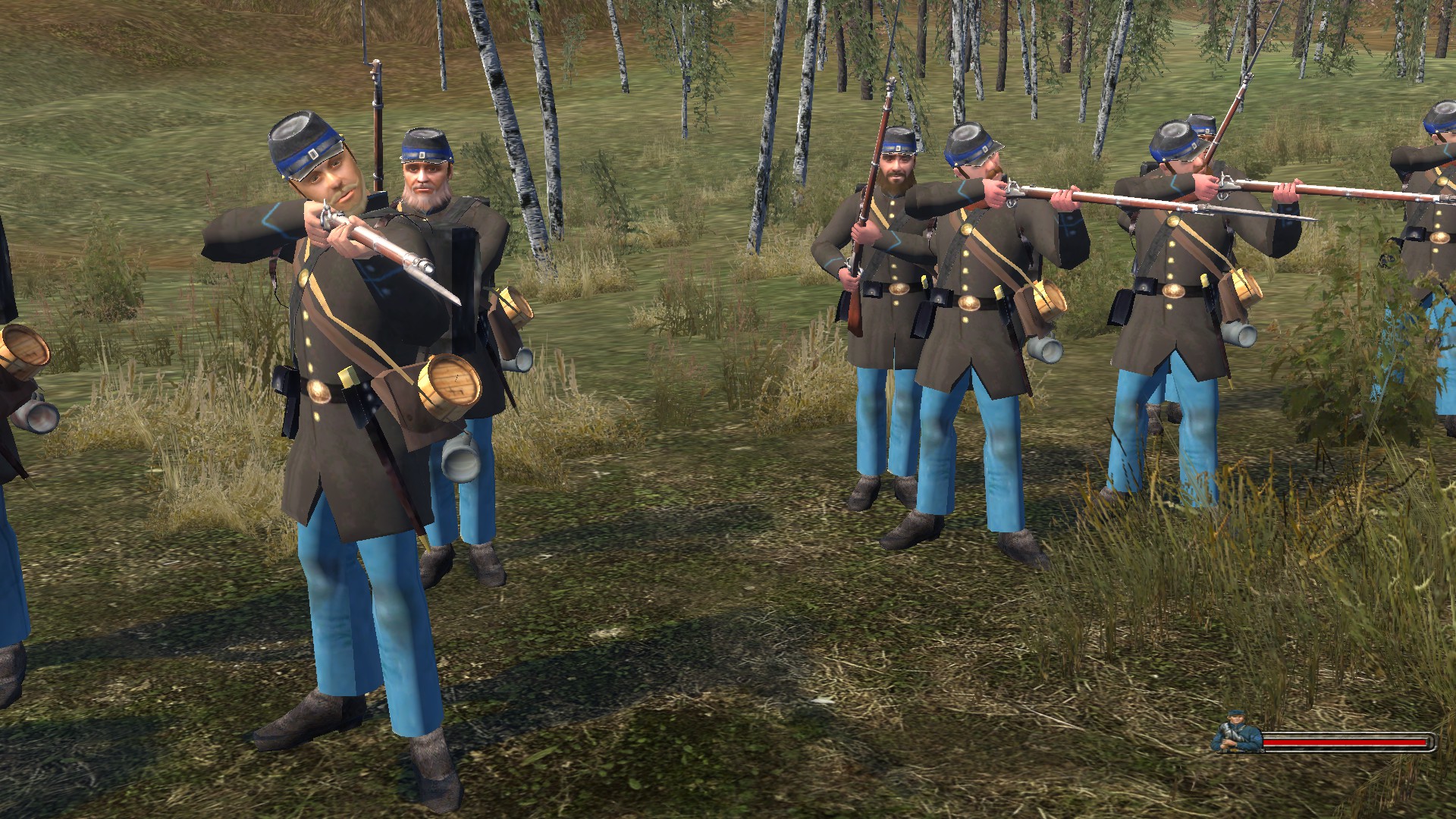
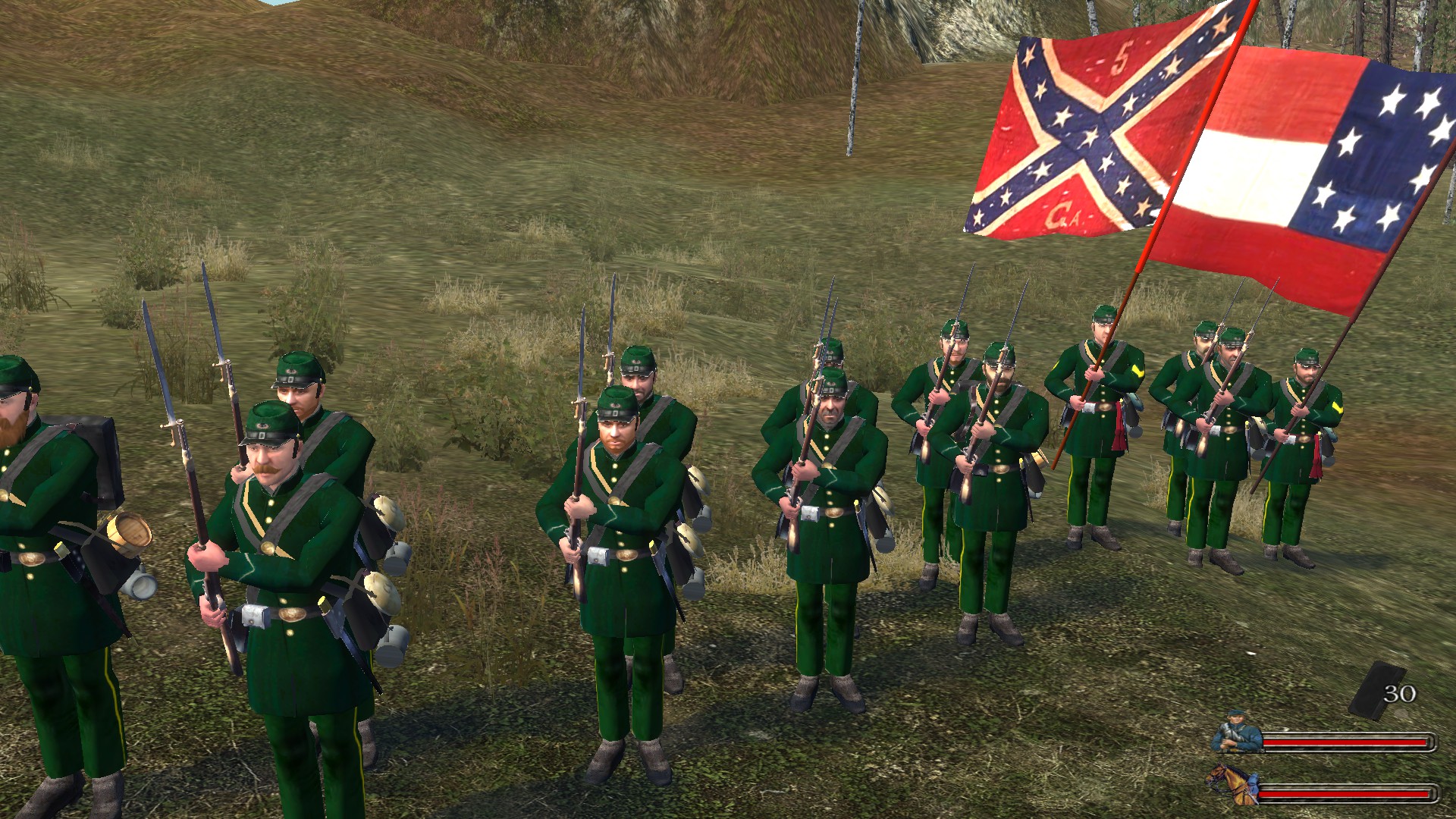
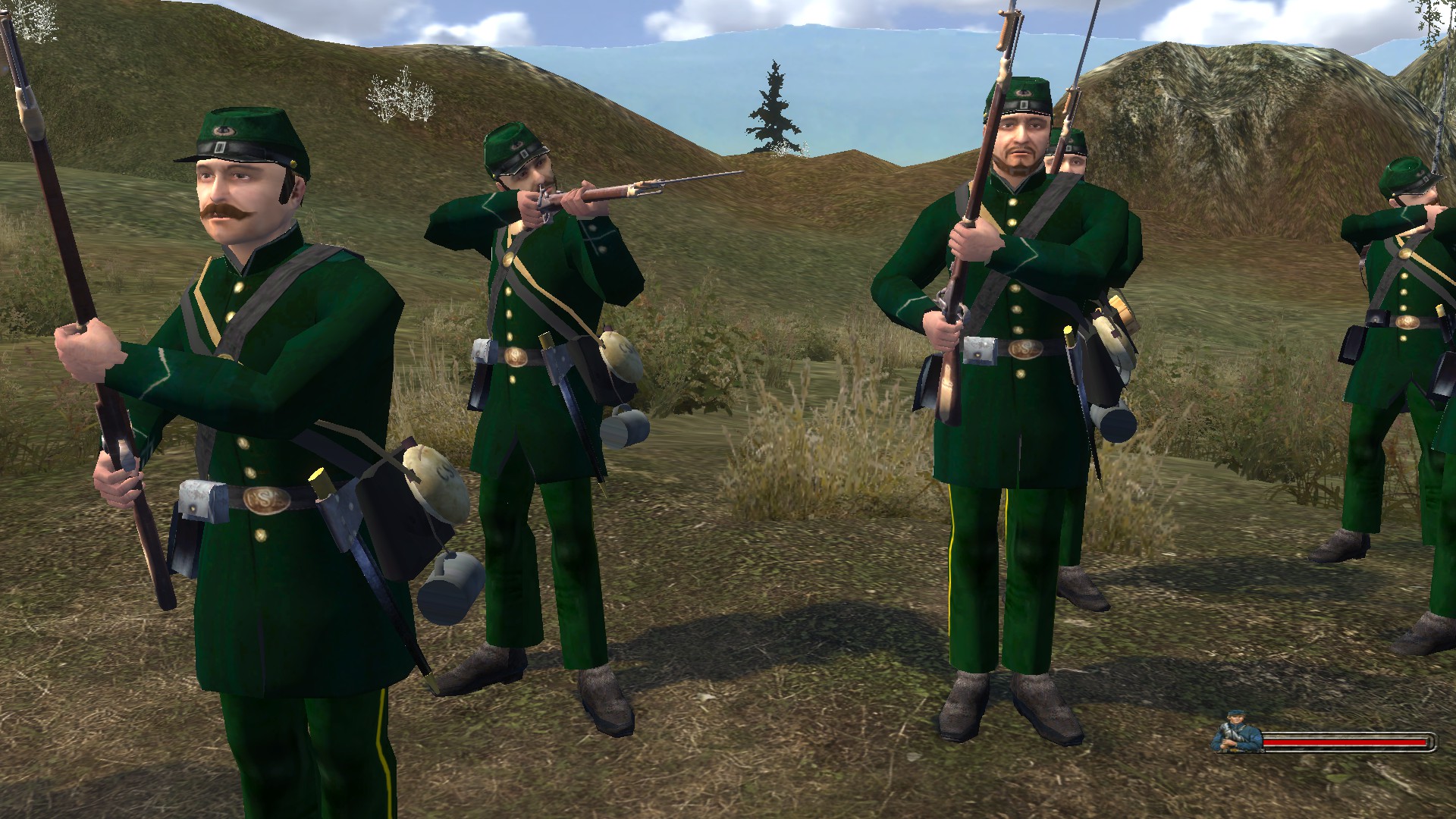

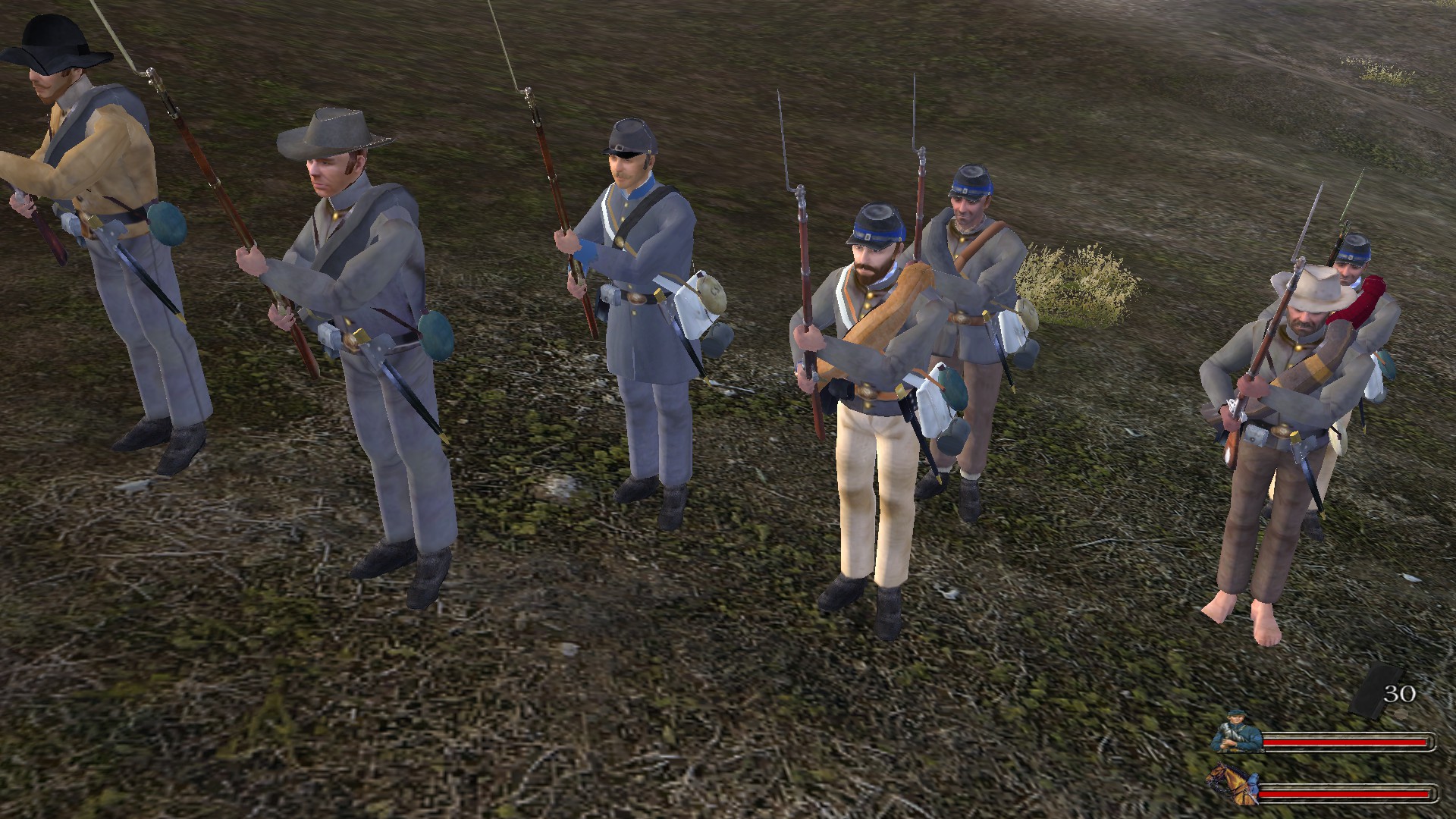
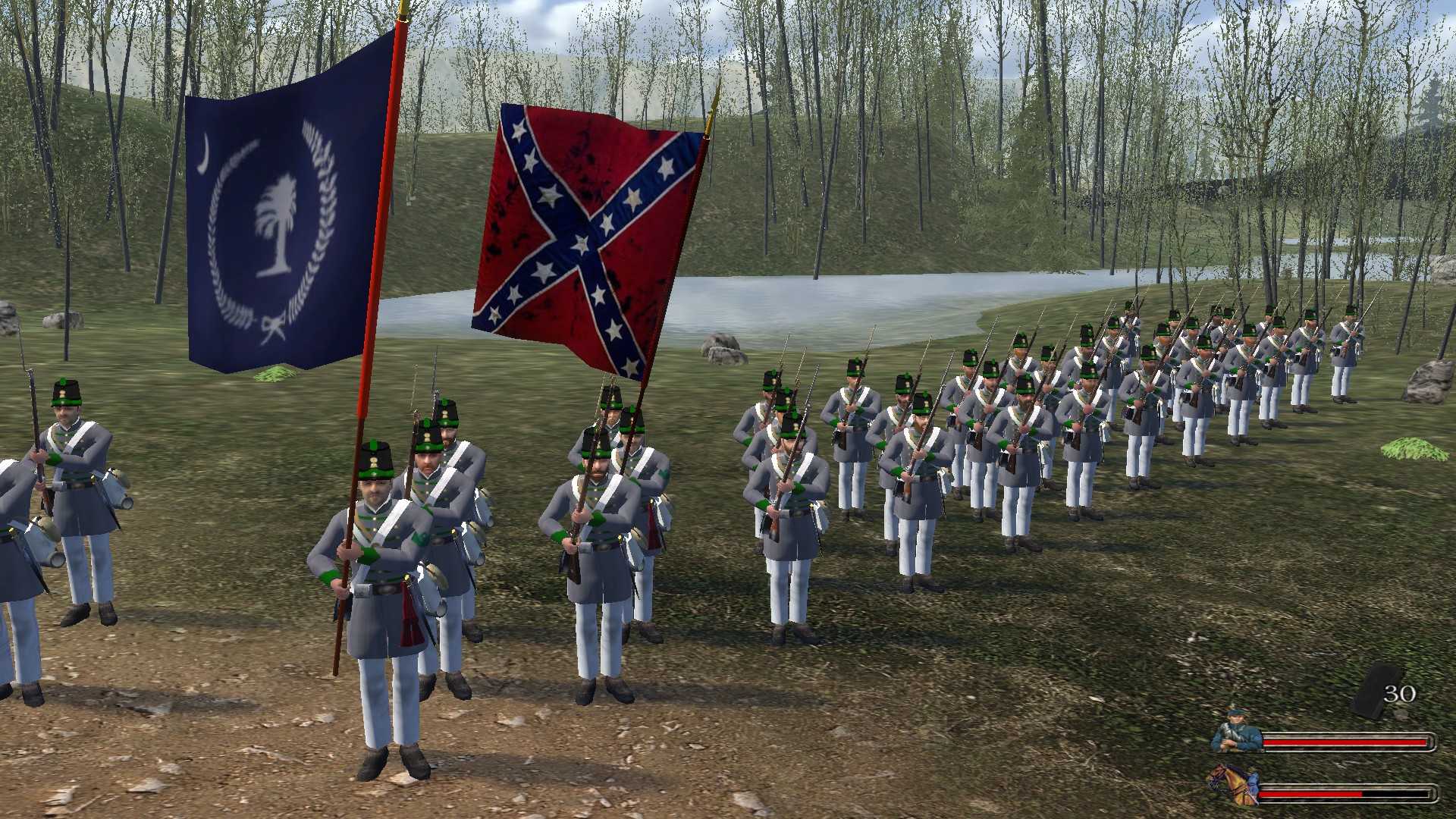
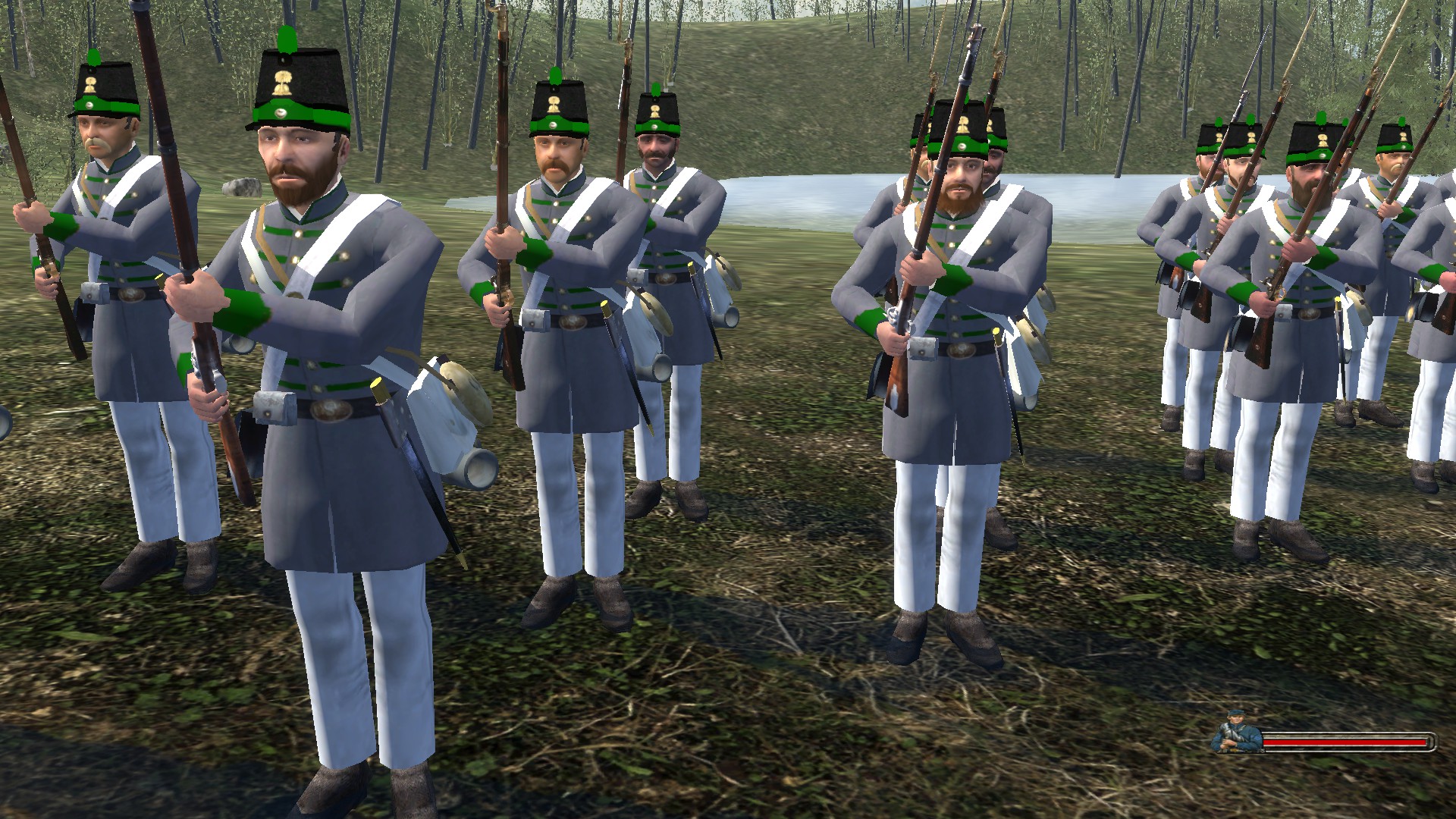

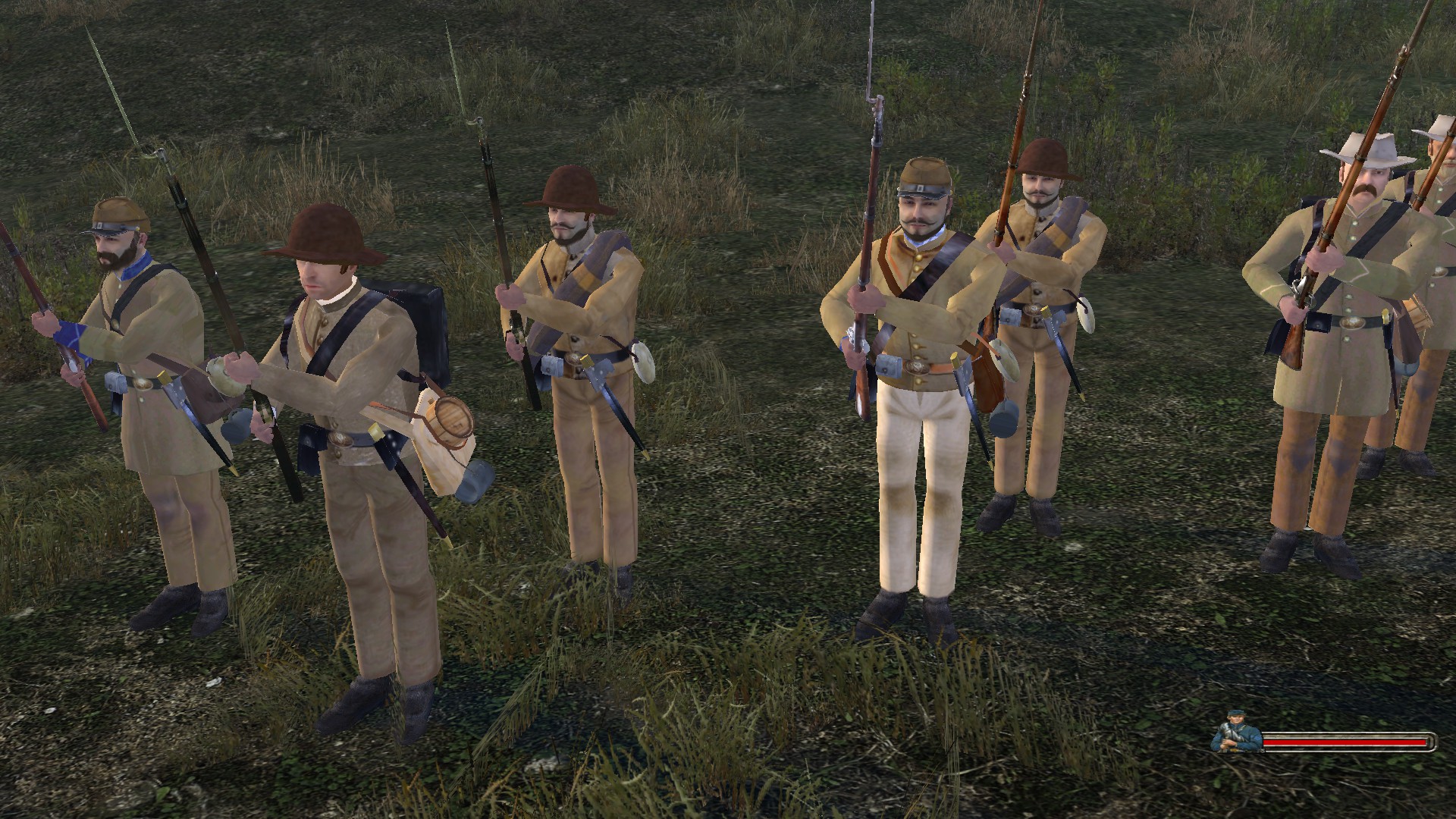
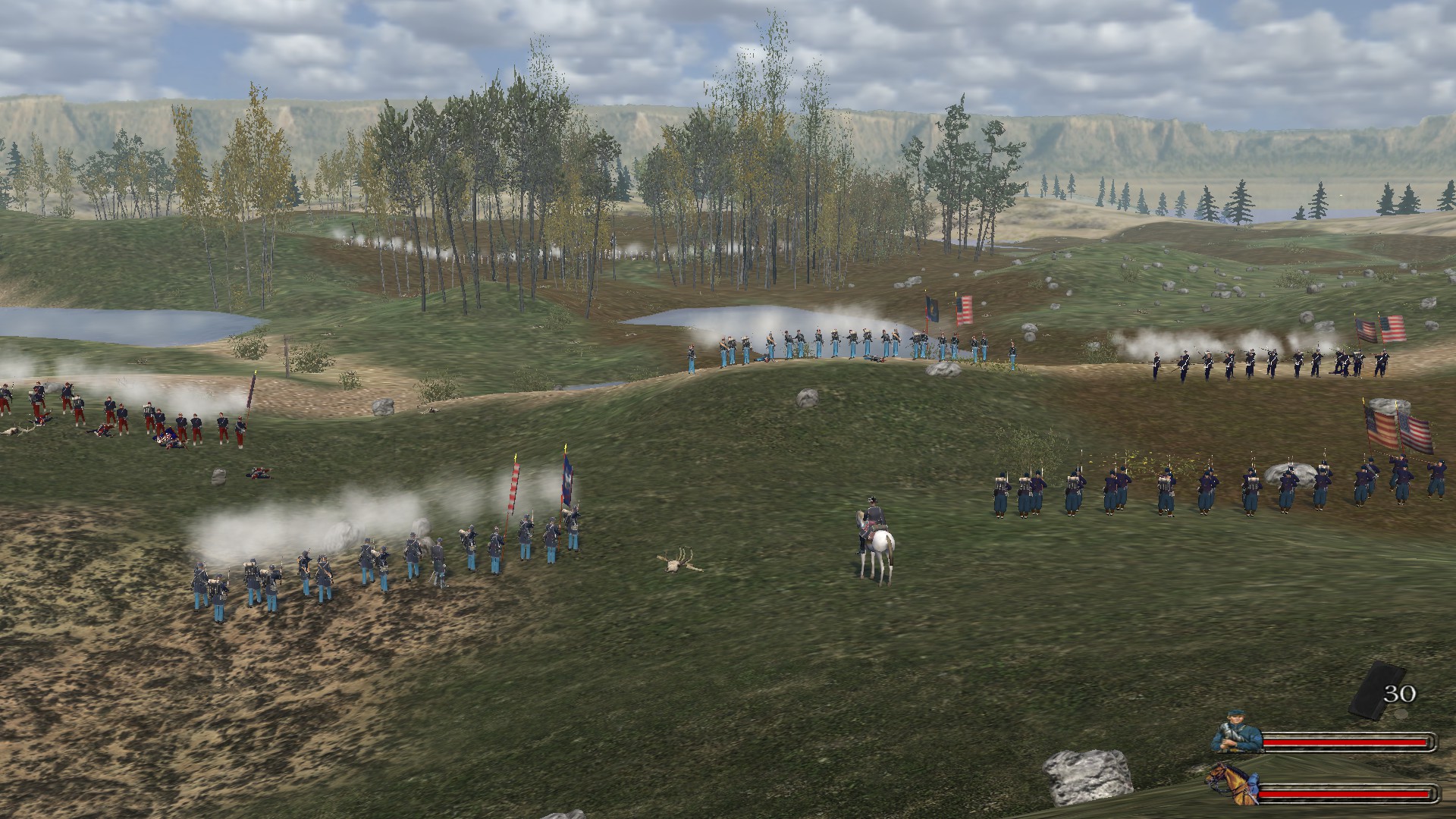


Excellent models and write ups, love for the subject and accurate details shines through
Thank you! We look forward to revealing more very soon :D
Damn, I didn't notice this one, when it came out. o_O
Sorry for that.
I've just finished reading and as always I am really glad about the progress you're making.
I'm not so sure about the Edisto & Clinch Rifles though. Were they able to maintain the looks of their uniforms throughout the war?
But at this point I'm wondering... How many mods on the troop-trees does the base game even support before issues are coming up?
Same for the variety of clothing/armour items.
Did you encounter any problems so far?
Hey Rotz! Always glad to hear from you.
In regards to your question about the uniforms, the Clinch Rifles began to use standard Confederate uniforms later on in the war, and it was likely the same with the Edisto Rifles. Even though the uniforms weren't worn throughout the war, I think it is acceptable for them to still be in the mod because it provides a nice variety to the appearances of the soldiers, who otherwise would be indistinguishable from the generic troops. They also would probably still be using those uniforms by the period in time the game starts at (March 1862).
I haven't really experienced any issues so far. I've had some crashes here and there, but it seems to be a fluke that could have been just my computer being on for too long. Still have to do testing before the release anyway. In terms of variety of clothing/armor items, there isn't a problem with the amount of them in the mod, as there are mods with thousands of custom items with no problems. Problems most likely would arise in large battles with lots of troops using different uniforms. This can be problematic, since the AI armies tend to be made up of lots of various soldiers from different units.
However, I have been fighting large battles with 300 soldiers on screen at once, many times with a variety of uniforms and fighting off multiple waves, and there were no problems. The crashes I experienced really did appear random, there was no apparent cause due to the mod that I could see, and they did not repeat when I went back and fought the same battle again. I am still wary though, because previous experience has shown that not everyone experiences the same level of stability with the mod that I do, so we'll do some private play testing before release and hopefully we can catch any problems. After that, it's just fingers crossed and hope for the best!
I guess I'll mix them with a few more ragged looking troops then. That should do the trick. ^^
I've fought similar battles from time to time and did not encounter any huge problems. So I guess there won't be any crashes related to this in the future too.
I was just wondering, because you've added so many different troops already.
Do you have any plans for adding some native soldiers to both sides? I mean, they were heavily engaged in the western theater, if I'm correct. Also the Cherokee Chief/Brigadier general Stand Watie was the last Confederate general to surrender to Union forces as far as I know.
Not a bad idea to mix them with the ragged looking troops, would be a good reflection of the regiments being consolidated after taking casualties.
In terms of the crashes, I don't think they are caused by all the new uniforms and such, since it is all split up in the BRF's at very low numbers now, and that has noticeably improved performance. But I suspect there is more to the crashes than just that, because I did encounter some crashes with battles against the mule trains, but it is not consistent, because I fought another battle with them in a new game and there were no crashes. The large field battles and sieges also seem to be stable and I don't get crashes in either scenario. Very weird. Will be tough to root out the core of the problem.
We actually had plans to add a Union and Confederate Native American unit, and we made some stuff for them, but held off because it's really not finished and needs more work.
I guess I'll watch out for the mule trains then. The few crashes I got so far seemed to be kind of random. Nothing out of the ordinary for me. The usual hickups.
I'm glad to read that this one's on your list. Looking forward to it!
Besides the tremendous amount of new troops to send into the meat grinder, what else can we expect from the update?
great mod has a great future in the gaming community I hope it doesn't become a dead mod (3)
Sponsored by: Thanos